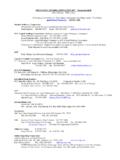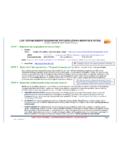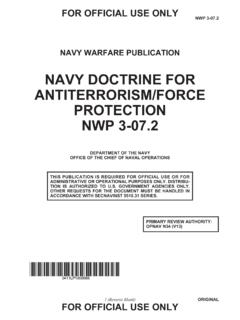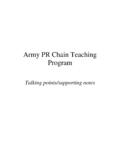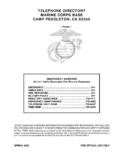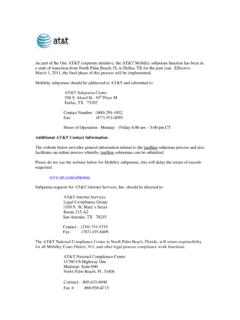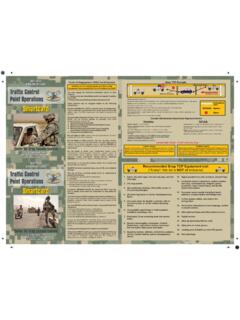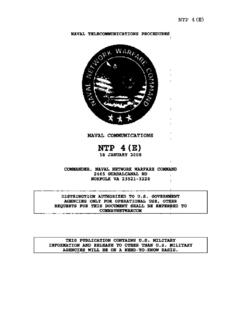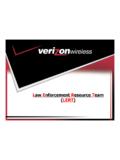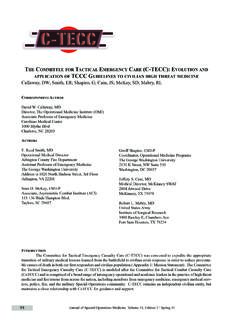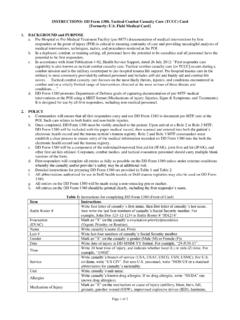Transcription of Handling Instructions for CALL - Public Intelligence
1 UNCLASSIFIEDREL NATO, ISAF, FVEYFor Official Use OnlyHandling Instructions for call Electronic Media and Paper ProductsCenter for Army Lessons Learned ( call ) authorizes official use of this call product for operational and institutional purposes that contribute to the overall success of , coalition, and allied information contained in this product reflects the actions of units in the field and may not necessarily be approved Army policy or product is designed for official use by , coalition, and allied personnel and cannot be released to the Public without the consent of call . This product has been furnished with the expressed understanding that it will be used for official defense-related purposes only and that it will be afforded the same degree of protection that the affords information marked UNCLASSIFIED, For Official Use Only [FOUO] in accordance with Army Regulation (AR) 380-5, section military and civil service/government personnel, to include all coalition and allied partners, may paraphrase; quote; or use sentences, phrases, and paragraphs for integration into official products or research.
2 However, integration of call UNCLASSIFIED, For Official Use Only [FOUO] information into official products or research renders them FOUO, and they must be maintained and controlled within official channels and cannot be released to the Public without the consent of product may be placed on protected UNCLASSIFIED intranets within military organizations or units, provided that access is restricted through user ID and password or other authentication means to ensure that only properly accredited military and government officials have access to these strictly forbid posting call UNCLASSIFIED, For Official Use Only [FOUO] documents to Department of Defense (DOD) websites that do not restrict access to authorized personnel. AR-25-1, 15 Jul 2005, Army Knowledge Management and Information Technology, paragraph 6-4 n (2) (b) and DOD Web Site Administration Policy and Procedures (11 Jan 2002), Part II, paragraph require appropriate mechanisms to protect sensitive no longer needed, all call UNCLASSIFIED, For Official Use Only [FOUO] paper products and electronic media will be shredded or destroyed using approved paper shredders or CDROM allied and coalition personnel.
3 This information is furnished with the understanding that it is to be used for defense purposes only, that it is to be afforded essentially the same degree of security protection as such information is afforded by the United States, and that it is not to be revealed to another country or international organization without the consent of UNCLASSIFIEDREL NATO, ISAF, FVEYFor Official Use OnlyThis publication is located online at: lename=/docs/doc7193 VERSION AVAILABLEA digital version of this call publication is available to view, download, or reproduce from the call restricted website, < >. Reproduction of this publication is welcomed and highly Access Card (CAC) or Army Knowledge Online (AKO) login is required to access the digital combat casualty CareHandbookTACTICAL combat casualty care UNCLASSIFIEDREL NATO, ISAF, FVEYFor Official Use OnlyForewordA decade of intense combat in two theaters has taught us many lessons about what works and what does not in the effort to accomplish that all-important mission of saving lives in battle.
4 A severely injured Soldier today has about twice the likelihood of surviving his wounds compared to Soldiers in wars as recent as Vietnam. That progress is the result of many things: better tactics and weapons, better body armor and helmets, better trained and fi tter Soldiers. But, the introduction of tactical combat casualty care (TCCC) throughout the Army has certainly been an important part of that is fundamentally different from civilian care . It is the thoughtful integration of tactics and medicine, but to make it work takes a different set of skills and equipment, and every Soldier and leader needs to understand it and practice handbook is the result of years of careful study of the care of wounded Soldiers, painstaking research by medics and physicians, and the ability of leaders at all levels to see and understand the lessons being learned and the willingness to make the changes in equipment, training, and doctrine needed to improve the performance of the Army Health System.
5 It is the best guidance we have at the time of publication, but new information, new techniques, or new equipment will drive changes in the future. Be assured that these performance improvement efforts will continue as long as American Soldiers go in harm s combat casualty care UNCLASSIFIEDREL NATO, ISAF, FVEYFor Official Use OnlyTactical combat casualty care HandbookTable of ContentsChapter 1. tactical combat casualty Care1 Section I: Introduction1 Section II: care Under Fire4 Section III: tactical Field Care7 Section IV: tactical Evacuation Care20 Section V: Management Guidelines23 Chapter 2. tactical combat casualty care Procedures41 Section I: Hemorrhage Control41 Section II: Airway Management47 Section III: Breathing Management53 Section IV: Vascular Access57 Section V: Hypothermia Prevention61 Section VI: Medication Considerations62 Appendix A.
6 Triage Categories63 Appendix B. Medical Evacuation Request67 Appendix C. Medical Evacuation Precedence Categories69 Appendix D. Roles of Medical Care71 Appendix E. combat Wound Pack75 Appendix F. Improved First Aid Kit77 Appendix G. Warrior Aid and Litter Kit79 Appendix H. Aid Bag Considerations81 Appendix I. National Stock Numbers83 Appendix J. References and Resources85viCENTER FOR ARMY LESSONS UNCLASSIFIEDREL NATO, ISAF, FVEYFor Official Use OnlyCenter For Army Lessons LearnedDirectorCOL Thomas H. RoeDivision ChiefLTC Vaughn M. GrizzleCALL AnalystDonald HausChief AuthorMAJ (Retired) Jeffrey Mott, DHSc, PA-CContributing AuthorsBrian Hill, PhD, PA-CLTC (Retired) Donald Parson, MPAS, PA-CCenter for Predeployment MedicineSubject Matter Expert ConsultantsCPT Larry Ake, MPAS, PA-CMAJ Joseph Dominguez III, MPAS, PA-CMAJ Felipe Galvan, MPAS, PA-CMAJ (ret) Mark Geslak, MPAS, PA-CCPT Michael Holloway, MPAS, PA-CCPT Donald Merrill, MPAS, PA-CCPT Miguel Moran, MPAS, PA-CMAJ (Retired)
7 Bret Smith, MPAS, PA-CCALL wishes to acknowledge the Army Medical Department Center and School s Center for Predeployment Medicine, the Committee on tactical combat casualty care , and the Army Institute of Surgical Research for their roles in compiling this Secretary of the Army has determined that the publication of this periodical is necessary in the transaction of the Public business as required by law of the otherwise stated, whenever the masculine or feminine gender is used, both are : Any publications (other than call publications) referenced in this product, such as ARs, FMs, and TMs, must be obtained through your pinpoint distribution combat casualty care UNCLASSIFIEDREL NATO, ISAF, FVEYFor Official Use OnlyChapter 1 tactical combat casualty CareSection I: IntroductionTactical combat casualty care (TCCC) is the prehospital care rendered to a casualty in a tactical , combat environment.
8 The principles of TCCC are fundamentally different from those of traditional civilian trauma care , which is practiced by most medical providers and medics. These differences are based on both the unique patterns and types of wounds that are suffered in combat and the tactical environment medical personnel face in combat . Unique combat wounds and tactical environments make it diffi cult to determine which intervention to perform at what time. Besides addressing a casualty s medical condition, responding medical personnel must also address the tactical situation faced while providing casualty care in combat . A medically correct intervention performed at the wrong time may lead to further casualties. Stated another way, good medicine may be bad tactics, 1 which can get the rescuer and casualty killed.
9 To successfully navigate these issues, medical providers must have skills and training focused on combat trauma care , as opposed to civilian trauma and WoundsOn the battlefi eld, the prehospital period is the most important time to care for any combat casualty . In previous wars, up to 90 percent of combat deaths occurred before a casualty reached a medical treatment facility. This highlights the primary importance of treating battlefi eld casualties at the point of injury, prior to tactical evacuation care and arrival at a treatment cally, combat deaths result from the following:2 31 percent: Penetrating head trauma. 25 percent: Surgically uncorrectable torso trauma. 10 percent: Potentially correctable surgical trauma. 9 percent: Exsanguination.* 7 percent: Mutilating blast trauma.
10 2 CENTER FOR ARMY LESSONS UNCLASSIFIEDREL NATO, ISAF, FVEYFor Official Use Only 3-4 percent: Tension pneumothorax (PTX).* 2 percent: Airway obstruction/injury.* 5 percent: Died of wounds (mainly infection and shock). *Potentially Survivable(Note: Numbers do not add up to 100 percent. Not all causes of death are listed. Some deaths are due to multiple causes.)A signifi cant percentage of these deaths (highlighted above in bold type) are potentially survivable with proper, timely intervention. Of these avoidable deaths, the vast majority are due to exsanguination and airway or breathing diffi culties, conditions that can and should be addressed at the point of injury. It has been estimated that of all potentially survivable deaths, up to 90 percent of them can be avoided with the simple application of a tourniquet for extremity hemorrhage, the rapid treatment of a PTX, and the establishment of a stable the battlefi eld, casualties will fall into three general categories: Casualties who will live, regardless of receiving any medical aid.

